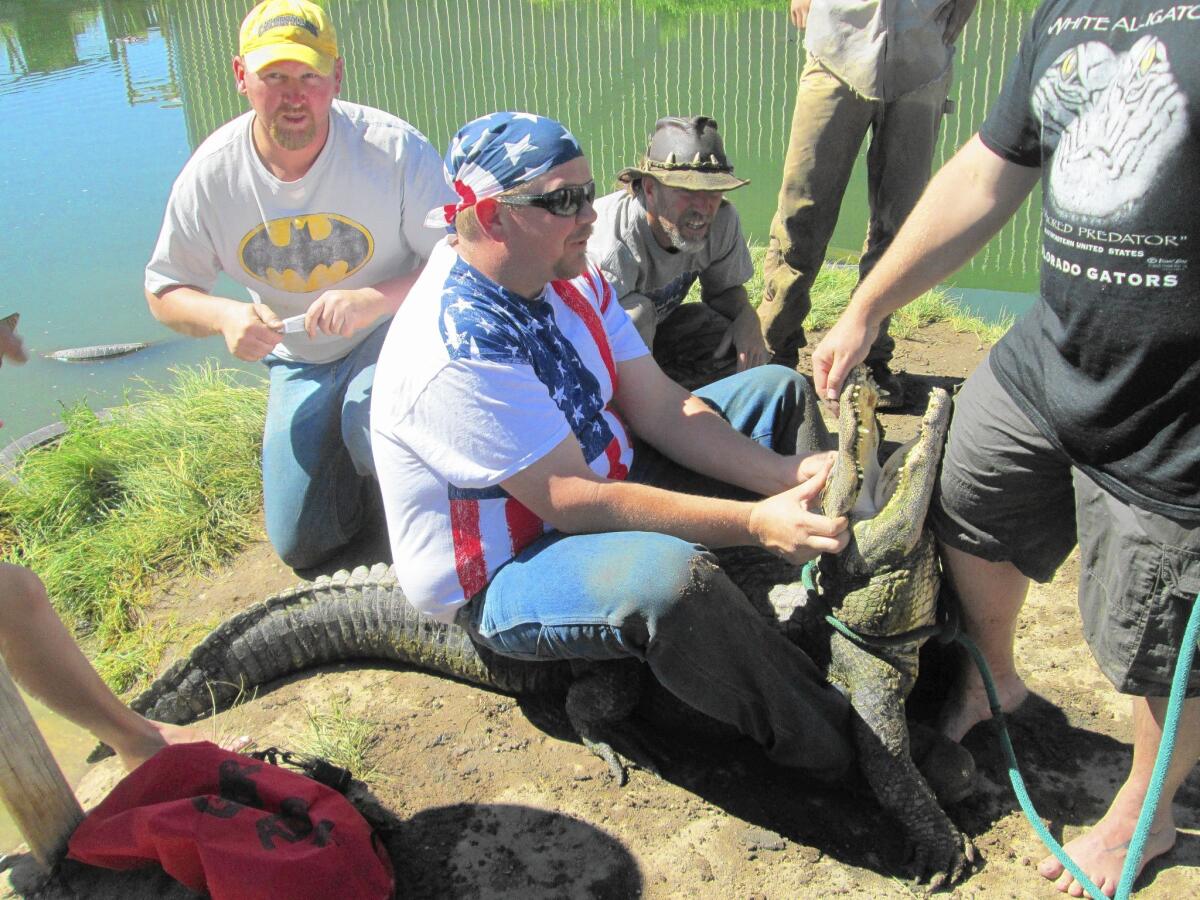Gator wrestlers grab life by the tail

As birthday presents go, it showed a certain style and a lot of bite.
Forgoing ties and cologne, Carrie McDougall gave her husband, Bill, something sure to make an impression.
“I surprised him with alligator-wrestling lessons,” she said.
Now knee-deep in murky water, surrounded by cold, unblinking eyes, he began to question the wisdom of her thoughtful gift.
“If something bumps your leg, don’t move,” warned instructor Drew Nelson. “Act like a tree.”
He did, though more quaking aspen than mighty oak.
“C’mon, Bill, just go grab one of them!” his wife bellowed from behind a fence. “Go get one, honey!”
A massive alligator roiled the water.
“Can I take the punt option?” he pleaded.
“No!” she snapped. “Now get your butt in there!”
For more than 15 years, people from around the world have visited Colorado Gators Reptile Park in remote Mosca, eager to go nose-to-snout with the predators.
They sign a waiver saying that if “you’re crazy enough to wrestle alligators you deserve to get bit,” and pay $100 for a three-hour class. So far none of the bitten wrestlers has sued.
“Most are adrenaline junkies looking for the next big rush,” said park owner Jay Young, who gets 200 students a year and says he runs the only genuine alligator-wrestling class in the world. “We also get the bucket-list crowd, the bored office worker and the animal-control people looking for experience in handling exotic pets.”
The bizarre roadside attraction, in the rugged San Luis Valley four hours south of Denver, is home to more than 300 rescued alligators basking in muddy ponds heated by hot springs that keep the water a constant 87 degrees.
It began as a tilapia farm in 1977 with 100 alligators trucked in to eat the fish that died before being sold. The facility still produces about 12,000 pounds of tilapia a year, but as it rescues more and more alligators, the reptiles have become the main attraction. The owners said they spend about $200,000 annually to run the place.
The Colorado Department of Agriculture, which monitors pet care facilities, does not regulate alligators.
“There are virtually no rules governing the treatment of captive alligators,” said Cynthia Thompson, a department inspector who visits the farm each year to check on its pet snakes, turtles and tortoises. “It’s a murky area.”
Young said he gets four or five complaints a year, often about wounded alligators.
“These wrestlers are paying to do what we would do anyway,” said Young. “They pull out the alligators, look for wounds and medicate them. If this didn’t help the animals, we wouldn’t do it.”
Not everyone agrees.
“Most reptile rescues employ veterinarians to assess and treat animals, not clueless thrill seekers,” said Kristin Simon, senior cruelty caseworker at People for the Ethical Treatment of Animals. “Alligators are shy, timid creatures terrified of humans riding and wrestling them.”
The animals are fast and pack a bite force of 2,000 pounds per square inch. Students have suffered serious lacerations to the face, arms and legs. One lost a finger, another nearly lost a hand.
“This is not a thinking man’s sport,” said Nelson, a veteran animal trainer. “There are two rules — don’t hesitate and don’t let go.”
On a recent day, Tim Czaplewski, 46, a restaurant manager from Waukesha, Wis., and Max Konbert, 19, from Bath, England, showed up for class.
Czaplewski, who was driving home from California, wanted to take the course after having seen it on the Discovery Channel. He denied being an adrenaline junkie, but admitted to skydiving.
For the gangly Konbert, it was part of a cross-country American odyssey.
“I couldn’t resist,” he said.
Nelson led them to a small pond crawling with 4- and 5-foot alligators.
“Grab one by the tail and pull it in,” he said. “Once you get it on land, drop on its back, put your feet under its armpits and get a tight grip on its neck.”
Konbert froze.
“Stop thinking!” Nelson cried. “Grab one!”
He waded in and dragged out a squirming 5-footer, dropped on its back and pulled the head up. Then he kissed it.
Nelson applied antibiotics to wounds the animal had received from other alligators.
When they waded into a larger pond, Nelson leaped atop an alligator and rode it across the lagoon. The others were hip-deep in the water looking for reptiles below the surface.
“How do you know what end you’ve got?” Konbert asked.
“If it bites, it’s the wrong end,” Nelson replied.
After grappling with a nearly a dozen alligators, a bedraggled Konbert called it “the experience of a lifetime.” Czaplewski pronounced it “awesome” before hopping into his car for the 22-hour drive home.
Bill McDougall and his three friends were next. They worked together at a sugar factory in rural Fort Morgan, Colo., and came to celebrate McDougall’s 37th birthday.
“This is one of the stupidest things I’ve ever done in my life,” said McDougall, sporting a matching American flag shirt and bandanna.
They gamely wrestled small, medium and large alligators.
As Nelson urged them into waist-deep water, McDougall looked ready to hop the fence.
“Just jump on one, Bill!” his wife yelled. “Get on his back and just go at him!”
A few feet away, Mike Holmberg wrangled Bertha, a huge alligator splashing in the muddy water.
“Now that’s livin’!” he exclaimed.
“You know what comes next?” McDougall asked. “Dying.”
Afterward, they all received “Certificates of Insanity” for “abandoning good judgment and endangering life and limb.”
“Happy birthday, Bill,” said McDougall’s weary friend Roger Wunsch. “Next year we’re running with the bulls.”
More to Read
Start your day right
Sign up for Essential California for news, features and recommendations from the L.A. Times and beyond in your inbox six days a week.
You may occasionally receive promotional content from the Los Angeles Times.






